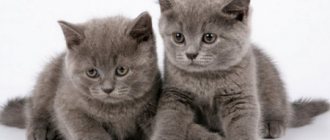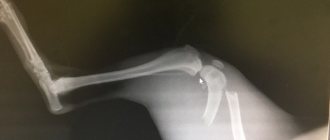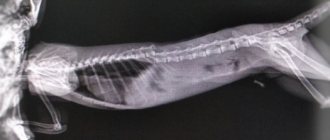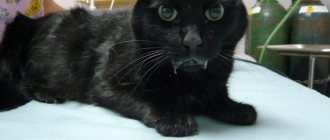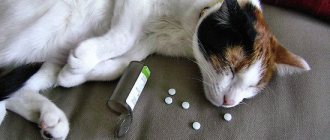Cats rarely experience panting, and sometimes your panting cat may be suffering from a serious illness. Therefore, to determine how to act if your cat is panting, it is quintessential that you first know all the reasons.
Cats pant due to overheating, playing in a warm environment for a long time, or due to stress. Other serious reasons why your cat is panting include early signs of diseases such as asthma, respiratory infection, heartworm, or even congestive heart failure.
Panting in cats is not common and you should immediately look out for signs that are causing panting and contact your veterinarian if necessary. Below we will discuss the main causes of panting in cats and other factors associated with panting.
Causes
Below we will discuss the top seven reasons why your cat is panting. Some causes do not require medical attention, but for more serious causes of wheezing, you should immediately consult a veterinarian you trust.
© shutterstock
- Excessive play time in extreme heat . One common reason your cat is panting is due to overheating. This may occur due to excessive play or exercise in hot climates. If your furry friend is panting as a result, stop your cat from any further activity and help her relax and cool down.
- Your cat is experiencing sudden stress . If there is a sudden change in your home, such as a new guest, a new pet, or a new building, your cat may become nervous and panting.
- Asthma . It may come as a shock to you, but cats are just as prone to asthma as humans. With this condition, your cat may develop allergies to environmental particles, which causes a narrowing of the air passages in the lungs.
- Respiratory tract infection . Your four-legged friend's respiratory tract may be infected with a virus, bacteria, fungus, or any other pathogen. This infection can lead to inflammation of the respiratory tract.
- Anxiety . An anxious cat will often pant and exhibit several other signs, such as strange behavior, excessive grooming, frequent urination, and changes in diet.
- Heart disease . Your cat can contract this disease from the bite of an infected mosquito. Signs include cough, shortness of breath and difficulty breathing. Talk to your veterinarian about measures to prevent this disease.
- Chronic heart failure . This is a serious disease that causes thickening of the heart muscles. This causes the heart to beat much faster, causing cats to pant. Your veterinarian will put your furry friend on oxygen therapy if a heart attack occurs.
Features of the respiratory system of kittens
The respiratory system of a kitten is not too different from a human:
1. Inhalation: the lungs inflate, due to which air is drawn through the nose, where it is warmed and filtered, passes through the pharynx into the larynx, from there into the trachea, then into the bronchi and lungs.
2. From the lungs, oxygen enters the blood and is distributed throughout the cells of the whole body.
3. Exhale: the diaphragm relaxes, nitrogen, oxygen and carbon dioxide are removed from the bronchi.
In addition to supplying the blood with oxygen, breathing performs the function of thermoregulation by removing excess fluid.
The respiratory rate of adults is on average 30 inhalations and exhalations per minute, in kittens it is approximately 40-50. Moreover, this indicator is approximate and unstable; it depends on many factors, both the environment and the internal state of the animal.
Why is my cat breathing heavily with her mouth open?
If your cat is breathing heavily with her mouth open, it means she is very stressed or overheated. In some cases, difficulty breathing with your mouth open also indicates an underlying medical condition that you may not be aware of.
If your cat is panting with an open mouth, you should have her examined, as this may indicate the following serious conditions:
- Asthma
- Tumor
- Heart failure
- Cancer
- Lung damage and fluid accumulation around the lungs
First aid for burns of the ears, nose, nasopharynx
If external damage of the first degree occurs, the skin is treated with a special product - ointment or foam. If necessary, you can take a pain reliever. If the damage to the integrity of the skin is more serious, you need to blot the surface with a weak solution of potassium permanganate and apply a dry sterile bandage. Next, seek medical help. The victim should drink more. Opening blisters is strictly prohibited - it will cause infection.
The degree of damage in internal burns is determined only by a doctor. Chemical injuries also require specialist supervision. If you know what caused it, then in the first minutes:
- The effect of alkali is neutralized with a weak solution of acid (1%) - citric, boric or acetic.
- If the cause is contact with acid, use alkali (2% baking soda solution).
- If there is no neutralizing agent, you can use ordinary boiled water for rinsing.
- When the cause is contact with quicklime, it is important to completely eliminate interaction with water. Use any vegetable oil.
- Medical assistance must be received within a maximum of six hours.
What to do
If you want to prevent your cat from panting, the first thing you need to understand is why your cat is panting. Below we have discussed in detail the measures you should take under different scenarios. So, first determine the cause of shortness of breath and then follow our advice.
Shortness of breath due to overheating
- Take your cat near an air conditioner or somewhere cooler.
- Provide your cat with water. Your cat may not drink water just because she's a cat! Be more creative and bring your cat to a moving water source, such as a faucet, and let him drink the water.
- If your cat won't drink water, you can try to cool her down by soaking a towel in water and placing the cloth over her ears and paws.
- If you're on a picnic, it's best to pack up and head home. Be sure to cool the car to cool the cat.
© shutterstock
Shortness of breath from exertion
- If your cat becomes overexerted, such as while playing or running around her favorite toy, you should stop the activity and give her a chance to calm down.
- Place your cat in a place where she usually likes to sleep, or perhaps place her on your lap. This will give her warmth and comfort.
Shortness of breath due to stress
- Determine the cause of your cat's stress. This could be the company of another pet or an unknown person. In this case, you should take your cat away for a while.
- If your cat is stressed from traveling, you should stop traveling for a while and take a break until your cat relaxes.
- Cats often become stressed in new and open places, such as the beach. In this case, you can calm the cat, take her on your lap and make her comfortable.
Shortness of breath due to illness
- If your cat continues to pant even after trying all of the above options, it may indicate a serious medical condition such as asthma.
- In this case, it is better to visit a veterinarian than to try to treat the cat yourself.
Treatment of burns of ENT organs
Even when it seems that the damage is minor, it is better to see an otolaryngologist. If the injury occurred due to contact with a complex chemical compound or an aggressive cleaning agent, then take the packaging with you. A specialist will study the composition of the substance.
For severe burns, antishock medications are indicated. If breathing is difficult, there is severe swelling, prednisolone or calcium chloride is used.
A tracheostomy is performed to restore breathing.
Medical appointments are conducted by ENT specialists with almost 10 years of experience. At your appointment, you will be treated with affected tissues and mucous membranes, and a pain reliever will be selected. If necessary, they will arrange a consultation with a surgeon or refer you to a hospital. The center is open all week, seven days a week.
Other Considerations
While panting may indicate that your cat is stressed, overexerted, or overheated, you should consult your veterinarian without delay if you notice prolonged panting.
As discussed earlier, shortness of breath can indicate various underlying medical conditions that can be fatal if not detected and treated early. If you notice shortness of breath accompanied by the following signs, call your veterinarian immediately:
- Severe drooling
- Weakness
- Lethargy
- Nosebleed
- Bright red tongue.
- Vomit
- Diarrhea
Some tests that a veterinarian may perform include:
- Heartworm testing
- Blood tests for anemia and diabetes
- Ultrasound
- ECG
In short, try to stop your cat's panting or consult your veterinarian.
How is respiratory failure treated in dogs and cats?
Treatment of pulmonary failure in animals is a complex process. It includes several stages, the first is stabilization of the patient’s condition, the second is diagnosis, the third is direct treatment of respiratory failure. To make it more convenient for you to understand how treatment occurs, let’s talk separately about each of these stages.
Initial stabilization
It is necessary to stabilize the animal’s condition, prevent the development of complications and give the veterinarian time to diagnose. Initial stabilization usually includes:
- Oxygen therapy. It is performed with or without sedation. The most common approach is to use an oxygen cage with a high proportion of inspired oxygen (eg, 40-60%). Additionally, the veterinarian may use a face mask or oxygen hose. In extreme cases, cats and dogs require emergency intubation as well as a higher proportion of inspired oxygen (eg, 100%).
- Sedation. It is used in conjunction with intubation and ventilation if the pet is experiencing severe anxiety. Some animals, particularly dogs with upper airway obstruction, require stabilization with special sedatives. After their introduction, the veterinarian clears the animal's mouth of any obstructing material (for example, secretions), and then performs intubation or tracheostomy.
- Decrease in temperature. An increased respiratory rate often leads to hyperthermia, so cooling the animal is one of the stages of initial stabilization. To do this, cover the cat or dog with damp towels, use fans, and apply alcohol to the armpits, groin area, and feet. The decrease in temperature stops as soon as the temperature reaches 38 ° C in order to prevent the opposite effect - hypothermia.
Diagnostics
To make an accurate diagnosis, doctors at a veterinary clinic in Moscow assess whether the pet has a natural predisposition to upper respiratory tract obstruction (for example, English bulldogs have a predisposition to brachycephalic respiratory tract diseases), cardiogenic pulmonary edema, as well as lower respiratory tract obstruction caused by asthma.
The next stage of diagnosis is collecting an anamnesis. The doctor asks several questions of the pet owner to determine possible causes of pulmonary insufficiency (for example, blunt trauma to the dog reported by the owner may cause pulmonary contusions or pneumothorax, which are symptoms of pulmonary insufficiency).
Next, a clinical examination is carried out, and after the cat or dog’s condition is restored, an extensive diagnosis is carried out:
- blood analysis,
- Ultrasound, CT scan of the chest,
- echocardiography (ECG),
- respiratory tract examination,
- respiratory fluid analysis.
Therapy
Treatment depends on the diagnosis, which determines the cause of chronic or acute respiratory failure in cats and dogs. For example, if it is caused by lower airway obstruction due to mucus buildup or bronchial inflammation, treatment would include bronchodilators and corticosteroids and, if necessary, deworming.
If respiratory failure is caused by pneumonia, pulmonary edema or other pulmonary parenchymal diseases, treatment involves the use of broad-spectrum antibiotics. If the cause is pulmonary thromboembolism, then therapy includes taking anticoagulants and antiplatelet agents.
Remember that effective treatment of pulmonary insufficiency in cats and dogs is only possible with timely access to a veterinary clinic. The specialist will urgently take measures for initial stabilization, accurate diagnosis and treatment, the methods of which directly depend on the cause of respiratory failure.


